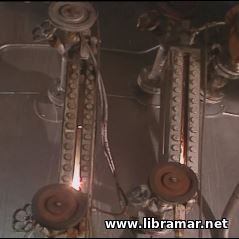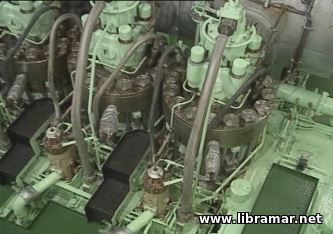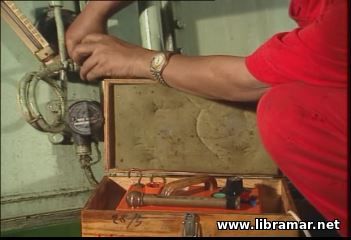Shipboard Machinery Alarms and Protection Devices (Cont.)

This article continues to discuss the shipboard alarms and protection devices. And now, let us look at sensors starting with level indicators. These monitor liquid level in fuel tanks, lube oil tanks, boilers and the like. The simplest systems are activated by the liquid itself. The device is activated by the level of fluid rising or sinking above or below the set safety levels. When this occurs, a sensor sends a signal to the warning devices, coupled usually with the indicator. One of the most important level alarms on board ship monitors boiler water level. It is critical to maintain right water level in boilers, especially in high-pressure water tube boilers to ensure safe operation.
A very dangerous situation can rapidly arise if the water quantity inside the boiler is not maintained at the correct level. There are visual level indicators as well as alarm systems monitoring the water level to ensure that the level is within set safety limits. Once we are dealing with boilers, we must mention a unique sensor in the alarm circuit known as the flame-out alarm system. A sudden loss of flame inside the boiler can lead to many undesirable consequences. Therefore, optical systems, or flame eyes, provide continuous monitoring of presence of fire and will give instant warning should the flame go out.
The main propulsion engines alarm and protection devices can be looked at as the most important ones on board ship. On a  typical diesel engine, these employ temperature and pressure sensors which monitor operational conditions to ensure optimal operation and effective lubrication. For example, the temperature sensors check the jacket cooling fresh water outlet, the lube oil inlet fuel oil inlet, and reduction gear lube oil inlet temperature. These are all of primary importance. The pressure sensors monitor the main lube oil inlet, reduction gear lube oil inlet, turbo charger lube oil inlet, and cooling fresh water inlet pressure.
typical diesel engine, these employ temperature and pressure sensors which monitor operational conditions to ensure optimal operation and effective lubrication. For example, the temperature sensors check the jacket cooling fresh water outlet, the lube oil inlet fuel oil inlet, and reduction gear lube oil inlet temperature. These are all of primary importance. The pressure sensors monitor the main lube oil inlet, reduction gear lube oil inlet, turbo charger lube oil inlet, and cooling fresh water inlet pressure.
Identical systems operate on other diesel engines such as those driving the generators. Because of their critical function, these sensors must be tested regularly in accordance with the ship's maintenance or test schedules to ensure their accurate function. Only sensors supplied with a valid calibration certificate or assurance of calibration should be installed and only calibrated test instruments must be used for testing. The quality control is on the measuring device attached to the testing instrument. Details of the test are recorded for future reference.
The alarm setting can usually be read from the central monitoring system provided that is can be demonstrated as operational. This is done by setting the alarm to normal value or by simulating the alarm value. But the most convenient method is the use a test pump and gauge. Testing level alarms sometimes involves activating the alarm manually. The test results should then be recorded. All these tests are important to ensure that the monitoring system is reliable at all times. The ship's manual will provide necessary details of each test applicable to the systems on board. Each engineer on board must know the alarm and protection systems thoroughly including their relative importance to the ship's proper function.
 Each time an alarm activates the duty engineer must be able to answer a number of critical questions:
Each time an alarm activates the duty engineer must be able to answer a number of critical questions:
- What does that alarm signify?
- How important is the system to which it relates?
- What measures must be taken to eliminate the cause of the alarm condition?
- In what order shall the countermeasures be executed?
In conclusion, it is essential that you know your ship's alarm system and protection devices, that you pay special attention to the critical alarm circuits on board ship, that you always follow the alarm systems maintenance schedule and ensure that all sensors and display systems are fully functional. When an alarm condition arises, never press the reset without noting the cause of the alarm. If an adjustment must be made to temperature or pressure switches, use calibrated instruments and take into account the direction of change.
When an adjustment has been made, always repeat the tests at different values. No adjustment should be permitted without checking at least two values afterwards. Where an automatic restart circuit is involved, it should always be switched to manual and off before pressing reset to avoid the machine starting automatically when reset. Equipment should never be restarted or put back  into service without rectifying the cause of the alarm trip. Any abnormal run indication should always be investigated even if the equipment is apparently running smoothly.
into service without rectifying the cause of the alarm trip. Any abnormal run indication should always be investigated even if the equipment is apparently running smoothly.
The engineer on watch must have confidence in the alarm systems and protection devices in the engine room. He must be sure at all times that he would be given timely warning of any changing condition which may lead to breakdown so that he can take remedial action. This confidence is an essential component of good engineering practice.
The "Read Later" function allows you to add material to this block with just one click. Just click on the icon and read the articles that interest you at any convenient time.


